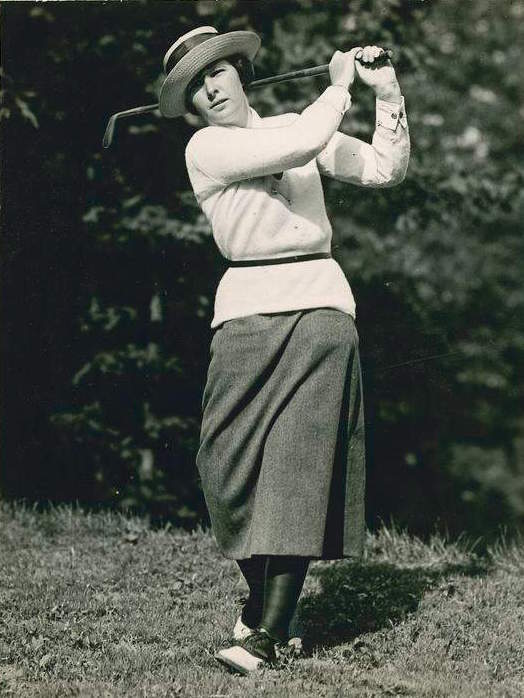In Larry Gilhuly’s opinion, the three biggest issues facing the game of golf are pace of play, player enjoyment and economic sustainability. Larry believes he has the solution for all three: “The answer for all of these, in my opinion, are properly placed forward tees.”
This week our host Colin Weston speaks with Larry Gilhuly, who is an Agronomist with The United States Golf Association and a passionate advocate of the TEE IT FORWARD program.


Join our mission to make golf more innovative, inclusive and fun... and WIN some awesome golf gear!
As the creator and host of The ModGolf Podcast and YouTube channel I've been telling golf entrepreneurship and innovation stories since May 2017 and I love the community of ModGolfers that we are building.
I'm excited to announce that I just launched our ModGolf Patreon page to bring together our close-knit community of golf-loving people! As my Patron you will get access to exclusive live monthly interactive shows where you can participate, ask-me-anything video events, bonus content, golf product discounts and entry in members-only ModGolf Giveaway contests.
I'm offering two monthly membership tiers at $5 and $15 USD, but you can also join for free. Your subscription will ensure that The ModGolf Podcast continues to grow so that I can focus on creating unique and impactful stories that support and celebrate the future of golf.
Click to join >> https://patreon.com/Modgolf
I look forward to seeing you during an upcoming live show!... Colin
TEE IT FORWARD is a joint initiative between the USGA and The PGA of America that encourages players to play from a set of tees best suited to their driving distance. In addition to providing more enjoyment for golfers, teeing it forward also can be one of the most important steps that golfers take in improving pace of play.
A recent survey of TEE IT FORWARD participants found that:
56% played faster
56% are likely to play golf more often
83% hit more-lofted clubs into greens
85% had more fun
93% will TEE IT FORWARD again
New forward tees allow more golfers to play from a yardage that is appropriate for their swing speed and ability. They also help new players take up the game.
For much of his 35-year career with the United States Golf Association, Gilhuly was all about agronomy. His formal title with the USGA is Agronomist, West Region. In other words, Gilhuly is an expert on growing grass. But in recent years, Gilhuly has become passionate - very passionate - about teeing it forward. And by forward, he means way forward. “This topic that I am talking about has got me fired up,” Gilhuly told us. It was hard not to buy his argument. Gilhuly came armed with data to back up his claim that courses are too hard, even from the current forward tees, for average female golfers and senior players.
As we age, our swing speeds decline and so does the distance we hit the ball. The average female player, Gilhuly said, has a swing speed of about 60 miles per hour. She averages about 140 yards with her driver, 120 yards with her 3-wood and about 60 yards with her wedge. That makes it impossible for that player to hit greens in regulation on the vast majority of holes from the current forward tees at most courses. “There are a lot of golfers, males, who can reach the green in regulation with a lot of different clubs, but not the women,” Gilhuly said.
This isn’t a new problem. Gilhuly described an article headlined, “Women Handicapped By Men’s Courses.” It was written in 1917 by Alexa Stirling, a past U.S. Women’s Amateur Champion. “This has been a problem for a lot longer than I think we all realize,” he said.
U.S. Women’s Amateur Champion Alexa Stirling, Circa 1919

Over 100 Years Ago Stirling concluded that golf courses were set up for men to the detriment of female golfers. Thankfully, golf course operators are slowly starting to get it. Gilhuly and other 'Tee it Forward' proponents have been able to convince them that in order to set up a course so it presents an equal challenge to that faced by more accomplished players playing from the regular or back tees, the forward tees need to be moved forward, on average, about 1,000 yards.
“Properly placed forward tees give all players a good experience,” Gilhuly said. “Think about it, if you started a business from scratch and wanted to be successful, would you say 'let’s make sure in our model here that half of the population tries it once and quits.' I don’t think that is what you do. You try and encompass everybody. This is not just for female players. It is for everybody.”
From most current forward tees, which average in the neighbourhood of 5,200 yards, players with slower swing speeds have no chance of hitting greens in regulation on most holes. In fact, on many courses the only greens that can be reached in regulation for those players are the par 3s.
“For (average) females a par 3 should not be longer than 140 (yards), the length of a par 4 should not be over 260 and a par 5 should not be over 380,” Gilhuly said. “There is this magic number that I find at almost every course and it’s usually between 4,000 and 4,300 yards,” he said.
Click to watch the TEE IT FORWARD YouTube explanatory video

“That’s it. It always seems to fall in that category. People look at me and blink. They thought the course was short enough at 5,000. No, not even close. And then you can do combinations with these new tees and the (former) forward tees. That’s the whole idea of this. It is happening. Golf courses are starting to do this.” Players who never stood a chance of making pars and birdies now have that opportunity. And Gilhuly said the game becomes fun for them again.
New forward tees also prompt the stubborn older guys to move up to the former front tees. And they will make it easier for kids to begin the game. “Forward tees are good for the game,” Gilhuly said. “They are. They give everybody an option. Pace of play has improved when forward tees are added. All my friends who have lost their swing speed over the last 10 years are now playing what were the old forward tees.”
Gilhuly had another message for us: “Red is dead,” he said, referring to red tees. “I hate red colours,” he said. “If we could just do this one thing, get rid of the red tees. It is amazing what happens. Gilhuly said some courses have dropped colour-coded tees all together and started simply numbering their tees. “Start with 1 being the forward tee and work your way back,” he said. “Seniors will move forward. I guarantee it. I will buy you a beer if they don’t.
“Pace of play, player enjoyment and economic sustainability all improve with forward tees,” Gilhuly said in closing. “In my opinion this century-old mistake holds the key to our game. That’s a bold comment but it is so simple. If we just add these forward tees we will get more women into the game. There’s no question in my mind.”
